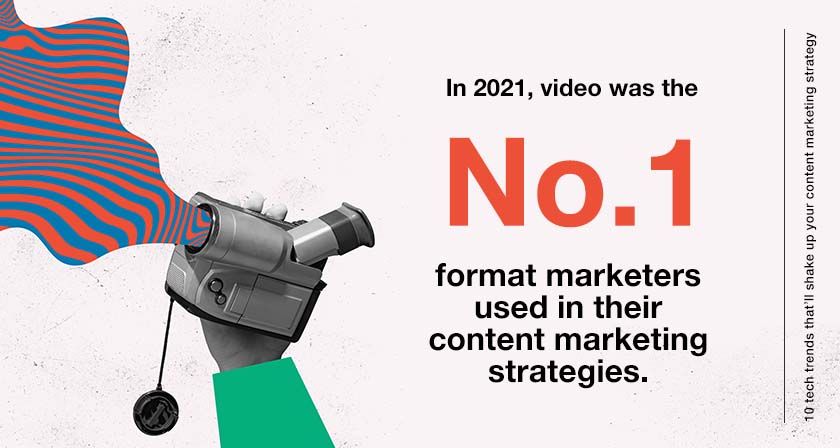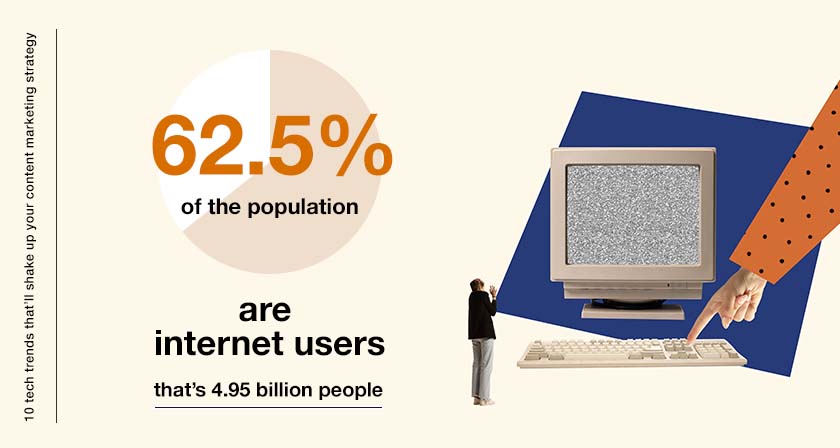
10 tech trends that’ll shake up your content marketing strategy (2022 Edition)
From virtual reality, mobile-only, and the march of artificial intelligence (AI), get ready for the new revolution in tech-inspired (and defined!) content marketing.
Note: This article was originally publish in January 2018 and has been updated for comprehensiveness.
The advance of content marketing continues apace. Late adopters are now well and truly in the content marketing strategy mindset, but leaders are forging ahead with new approaches, platforms, strategies, and tactics.
In 2018, I wrote an abridged version of this article and predicted how content marketing will be shaped and transformed by emerging technology. Five years have passed since, and the trends mentioned are more relevant today than ever.
Read on to learn what they are and why you should incorporate them into your content strategy, this year and beyond.
Content marketing has proven its success
It’s no secret: content marketing has matured. According to the Content Marketing Institute, 89% of B2B marketers in 2018 have a content marketing strategy. Over 60% of them reported that their strategies were more effective than the year before.
Not only that: the top brass got the message, too. 42% of respondents reported that management changes positively impacted their content marketing approach.
Since then, marketers’ faith in content marketing has only increased. Today, almost half (40%) of B2B marketers characterise their content strategy as sophisticated or mature. What’s more, 80% believe that their organisations value creativity and craft in content creation, suggesting that more businesses are more aware of best practices.
What’S next for your content marketing strategy?
As the field becomes ever more crowded, the challenge for content marketers will be to stand out from the crowd and stay ahead of the curve.
Technological shifts are driving new innovations and trends that will shake up content marketing in 2022 and beyond…
1. Multimedia content demands multimedia content creators
The days of relying solely on blog posts and eGuides are far behind us now. Online video has gone mainstream, and whether operating in the B2C or B2B space, brands cannot afford to ignore it.
And let’s not forget the well-documented rise of the podcast. This audience is overwhelmingly young (44% are 18-34) and tends to be more well-off than average, representing a fertile opportunity that brands are increasingly tapping into.
In 2018, I mentioned some of the key skills content teams will need to have going forward:
- Video production and editing
- Graphic design and illustration
- Audio editing and production
- Digital content creation
Were my predictions correct? Let’s discuss them in more detail.

Video production and editing
In 2021, video was the number one format marketers used in their content marketing strategies.
For B2C marketers, this was certainly because of TikTok’s explosive success. With over a billion users, the video-based social media platform has attracted the envy of YouTube and Instagram, causing them to incorporate some of TikTok’s features into their own platforms (i.e. YouTube Shorts and Instagram Reels).
Even B2B organisations could not ignore the importance of video production and editing. In fact, video content is the top investment for B2B brands this year, suggesting that more B2B marketers have a greater appreciation of how video can be used to enhance buyer journeys.
Graphic design and illustration
Dull, formal visuals have long defined the look and feel of most B2B brands, but this is changing. According to Hubspot, infographics are the fourth most used content format in 2022. What’s more, they have had the biggest increase in usage among B2B marketers in the last four years.
This suggests that buyers are less happy with reading long-winded marketing assets that only contain text.
Audio editing and production
Podcasts are now everywhere; every day, over 72,000 episodes are publish. Unsurprisingly, this high number reflects the sheer demand people have for audio content.
That means more content marketers (both B2C and B2B) are recording and releasing podcasts. Naturally, this requires audio editing and production skills, which are just as necessary as copyediting and image editing—after all, you don’t want people to listen to unpolished recordings!
Digital content creation
Digital content creation has been an important skill for a long time, but in 2022, it’s more important than ever.
As you probably already know, there’s a lot of content out there right now. Every time a consumer or buyer visits a social media platform, sophisticated algorithms are responsible for every ad and post they see. Content marketers must now be able to navigate these algorithms effectively and make better data-driven decisions if they want to stand out from the crowd.
2. It’s not just about the screen anymore
The internet of things has fully arrived. From Alexa to Siri, virtual assistants are invading homes and turning devices into content channels. This isn’t just hands-free; this is eyes-free, opening the door for delivering content in a whole new way.
A number of brands are using Amazon’s Alexa Skill platform to share expert demonstrations. One example is the American Heart Association, which can talk you through the process of performing CPR via Alexa.
Another brand using Alexa to deliver audio content is pet care company Purina. They’ve built an audio content hub that allows users to learn more about different dog breeds and health issues through the voice command ‘Alexa, Ask Purina…’.
Not to mention, B2B organisations are also benefitting from IoT devices. From autonomous vehicles to environmental sensors, more and more enterprises are transforming into fully digital businesses by using IoT data to train AI systems.
In fact, Gartner expects that over 80% of enterprise IoT projects will use AI by the end of 2022. In 2019, this was only 10%!
3. Paid, owned and earned media are converging
Content used to be placed firmly in the box of ‘owned’ media, with advertising classified as ‘paid’ and PR/influencer marketing as ‘earned’.
Now the old divisions are breaking down, not least because of the collaborative and interactive nature of the internet, the reduced brand control, and the desirability of co-creation with users and online influencers.
Those in the know are now talking about converged media, an approach that combines the best of each traditional category.
All three types of media—paid, owned, and earned—have to work together to support your brand’s content marketing strategy and growth goals.
In the next few years, you’ll likely notice a bigger increase in content atomisation (e.g. converting earned or owned media into paid online ads).
4. Live video is going BIG
Facebook has really led the way in the live video conversation, and the engagement stats show that this gambit is paying off. Users spend 3x longer watching live than non-live videos. And they comment 10x more, according to Facebook Newsroom.
And it’s not just Facebook reporting this. Livestream found that 80% of brand audiences would rather tune into a live video than read a blog post, and 87% crave behind-the-scenes content. However, back in 2016, only 14% of marketers used live video.
Today, live video is now the third most popular social media marketing tactic. This is most likely due to the recent popularity of live streaming (as brought on by the pandemic). Since early 2020, LinkedIn live streams have more than doubled, increasing by 158%. This growth is expected to be sustained, even as virtual events become less relevant.
5. Virtual reality (VR) will take a hold
VR is coming, like it or not (and you should like it!). A few years ago, brands and companies in the e-commerce sector have just started to explore opportunities that this form of interactive content could bring, especially to customers that want to be immersed in brand experiences.
Now VR is the next big thing. Revenue from virtual reality and augmented reality is predicted to skyrocket over the next few years—$6.71 billion by the end of 2022 and $12.9 billion by 2024, to be exact.
This is in no small part because of the metaverse’s meteoric rise in popularity. Leading consumer brands, like Gucci and Adidas, are now experimenting with ways to deliver innovative content using VR-enabled platforms like Roblox and Decentraland. All content marketers should keep a close eye on this exciting development.
6. The sheer volume of content continues to rocket
Your content marketing strategy runs the risk of becoming background noise if you’re not producing original and compelling stuff, distributing it via the right channels and continually measuring and optimising your output.
As far back as 2014, it was calculated that every single minute:
- 72 hours of video are uploaded to YouTube.
- 277,000 tweets are publish.
- 216,000 photos are shared on Instagram.
Three years on, the global internet population grew by over 1 billion!
2018:
- There are 3.8 billion internet users.
- There are 2.8 billion active social media users.
- There are 4.9 billion unique mobile users.
- There are 4.95 billion internet users, which is 62.5% of the global population.
- There are 5.31 billion unique mobile users, which is 67.1% of the global population.
- There are 4.62 billion active social media users, which is 58.4% of the global population.

And according to Hootsuite, some social media platforms are more popular than others—Facebook being the one with the highest number of active users.
Every day, all of these people are consuming (and producing) content. This growth is set to continue, making the race for content differentiation more urgent than ever.
7. Social media goes from sharing platform to publishing outlet
Users of social media increasingly crave native experiences, often preferring to consume content within the context of the platform they’re on, rather than clicking away to access it.
Platforms like Facebook and LinkedIn are understandably encouraging this, with innovations like automatic in-feed video playing and Instant Articles. Features on Snapchat and Instagram similarly allow users to read articles instantly, with a single swipe.
Content marketers need to stop trying to drive all social traffic to their websites and instead focus on providing a complete in-channel experience. As John Hall of Influence & Co said:
“Why would people leave their favourite social apps when they can get all the content they want in one place?”
8. Forget mobile-first, we’re heading for mobile-only
Is there still anybody out there without a mobile-friendly website?
If there is, they’re probably not reading this anyway. Mobile-friendly quickly became outdated as a concept when we realise the tide was advancing so quickly it was mobile-first or nothing.
But now we’re heading for the final phase which will see desktop use dwindle to next to nothing. In 2017, 69% of digital media engagement took place on mobile platforms. And in the US, 13% of the population only accessed content on their mobiles.
These numbers have increased significantly since. According to Statista, global mobile data traffic in 2022 is on track to be seven times larger than it was in 2017. What’s more, 61% of Google searches in 2021 took place on a mobile device—and this trend is showing no signs of slowing down.
That means having a website that’s fully optimised for mobile devices will play a paramount role in the success of your content.
9. Search engines get smarter, and self-updating
There has been a quiet but seismic shift in the way search engines (yes, mainly Google) operate. Marketers have become used to periodic high-profile updates such as Panda and Penguin which, while always having an impact, have been largely predictable and easy to adapt for.
That’s all changing with the rise of automatic, machine-learning algorithm updates.
Back in 2015, there was RankBrain. This Google algorithm fine-tunes search results based on user behaviour, continually optimising to serve up the best results and making it much tougher to predict or game the system.
Last year, Google announced that they will be rolling out an even more innovative update: the Multitask Unified Model (MUM). Dubbed the new ‘AI milestone for understanding information’, this technology represents the next paradigm shift for search engines. With MUM, Google will be able to solve difficult search queries using multiple forms of content (including images and video) in all languages to provide rich, nuanced answers.
This reinforces the point that content marketers in the future must be able to provide a versatile range of content formats.
10. Artificial intelligence (AI) — the content robots are coming…?
Resistance is futile, but acceptance could bring great rewards. Artificial intelligence is already being used by companies like Facebook and Google to manage how they sort, monitor and serve content. So why shouldn’t content marketers harness its power, too?
In 2022, industry leaders are continuing to experiment with AI to better understand keyword terms and intent, discover relevant content—and, of course—automate and optimise distribution.
However, content robots still aren’t very effective when it comes to producing original copy. Google’s recent ‘helpful content’ update also highlights the fact that written content created by humans will always be favoured by search engines over AI-crafted content.
Nevertheless, marketers might find more immediate success in AI-powered video or image content tools (you might’ve heard of DALL·E, the technology that can produce AI art based on your written instructions). Overall, one thing is sure: artificial intelligence will transform the way we create, distribute, and optimise content—and it’s up to content marketers to keep track of the latest technological advances.
Key takeaways
- Content marketing strategy is entering a new and exciting phase. Nearly all companies have embraced it, so the next challenge is for leaders to differentiate from the crowd.
- The rising popularity of video and audio content means that design and production skills will be increasingly important in content teams.
- Virtual reality and augmented reality are on course to grow massively, and provide an interactive opportunity to immerse customers in the brand experience.
- Social media and mobile usage will continue to skyrocket, and content must be created and shared in formats that fit seamlessly with these channels.
- Machine learning is making search engines less predictable, while artificial intelligence holds opportunities for greater efficiency and optimisation.
Ready to get ahead of the curve? Seize your headstart now! Read Dare to be different: The state of content marketing differentiation
Read the latest positioning trends and insights.
Tap into our brand and product positioning, storytelling, and creative expertise to inspire your next strategic move.


